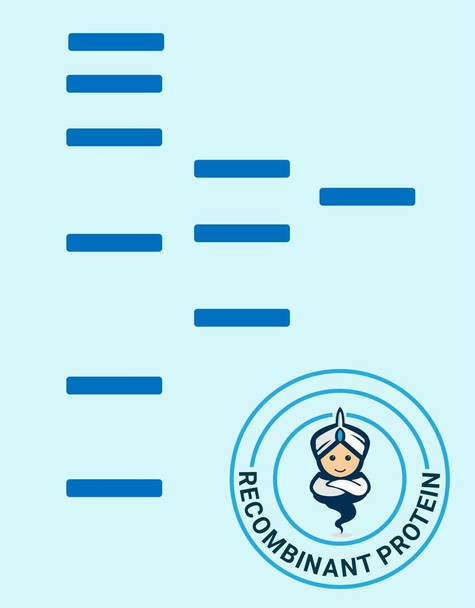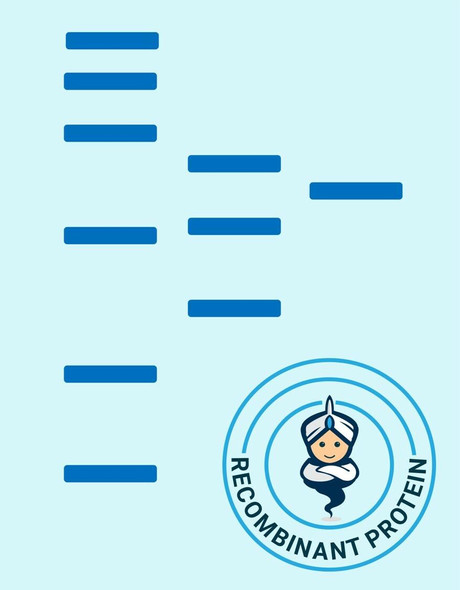Growth Factors & Cytokines Recombinant Proteins
Human AREG Recombinant Protein (RPPB0066)
- SKU:
- RPPB0066
- Product Type:
- Recombinant Protein
- Species:
- Human
- Uniprot:
- P15514
- Research Area:
- Growth Factors & Cytokines
Description
| Product Name: | Human AREG Recombinant Protein |
| Product Code: | RPPB0066 |
| Size: | 50µg |
| Species: | Human |
| Target: | AREG |
| Synonyms: | Schwannoma-derived growth factor, Colorectum cell-derived growth factor, AR, CRDGF, SDGF, AREGB, MGC13647. |
| Source: | Escherichia Coli |
| Physical Appearance: | Sterile Filtered White lyophilized (freeze-dried) powder. |
| Formulation: | Lyophilized from a 0.2�m filtered concentrated solution in PBS, pH7.4. |
| Solubility: | It is recommended to reconstitute the lyophilized AREG in sterile 18M-cm H2O not less than 100�g/ml, which can then be further diluted to other aqueous solutions. |
| Stability: | Lyophilized AREG although stable at room temperature for 3 weeks, should be stored desiccated below -18°C. Upon reconstitution AREG should be stored at 4°C between 2-7 days and for future use below -18°C.For long term storage it is recommended to add a carrier protein (0.1% HSA or BSA).Please prevent freeze-thaw cycles. |
| Purity: | Greater than 95.0% as determined by:(a) Analysis by HPLC.(b) Analysis by SDS-PAGE. |
| Amino Acid Sequence: | SVRVEQVVKP PQNKTESENT SDKPKRKKKG GKNGKNRRNR KKKNPCNAEF QNFCIHGECK YIEHLEAVTC KCQQEYFGER CGEKSMKTHS MIDSSLSK |
| Biological Activity: | Determined by its ability to stimulate the proliferation of mouse Balb/c 3T3 cells. The expected ED50 for this effect is 5-10 ng/ml, corresponding to a specific activity of 100,000-200,000units/mg. |
Amphiregulin (AREG) belongs to the EGF family of cytokines that contain 10 proteins such as EGF, TGFb, HBEGF, and the various heregulins. These cytokines are synthesized as transmembrane precursors and are categorized by the presence of one or several EGF structural units in their extracellular domain. The soluble forms of these cytokines are released by proteolytic cleavage. Initially, Amphiregulin (AREG) was isolated from the conditioned media of a PMA treated MCF 7 human breast carcinoma cell line. Multiple forms of native AR containing either 78 or 84 amino acid residues and both N and O-linked oligosaccharides have been found. Amphiregulin (AREG) mRNA expression can be identified in several carcinoma cell lines and the epithelial cells of numerous human tissues such as colon, stomach, breast, ovary, kidney, etc.
Amphiregulin (AREG) Human Recombinant produced in E.Coli is a single, non-glycosylated, polypeptide chain containing 98 amino acids and having a molecular mass of 11.3 KDa.The AREG is purified by proprietary chromatographic techniques.
| UniProt Protein Function: | AREG: Ligand of the EGF receptor/EGFR. Autocrine growth factor as well as a mitogen for a broad range of target cells including astrocytes, Schwann cells and fibroblasts. Belongs to the amphiregulin family. |
| UniProt Protein Details: | Protein type:Membrane protein, integral Chromosomal Location of Human Ortholog: 4q13.3 Cellular Component: extracellular space; cell surface; cytoplasm; integral to membrane; nucleus Molecular Function:protein binding; growth factor activity; cytokine activity; epidermal growth factor receptor binding Biological Process: epidermal growth factor receptor signaling pathway; response to peptide hormone stimulus; response to cAMP; response to glucocorticoid stimulus; response to estradiol stimulus; glial cell proliferation; cell proliferation; G-protein coupled receptor protein signaling pathway; cell-cell signaling; response to hydrogen peroxide; positive regulation of cell proliferation; negative regulation of osteoblast differentiation; neurite development; positive regulation of phosphorylation; positive regulation of DNA replication |
| NCBI Summary: | The protein encoded by this gene is a member of the epidermal growth factor family. It is an autocrine growth factor as well as a mitogen for astrocytes, Schwann cells and fibroblasts. It is related to epidermal growth factor (EGF) and transforming growth factor alpha (TGF-alpha). The protein interacts with the EGF/TGF-alpha receptor to promote the growth of normal epithelial cells, and it inhibits the growth of certain aggressive carcinoma cell lines. It also functions in mammary gland, oocyte and bone tissue development. This gene is associated with a psoriasis-like skin phenotype, and is also associated with other pathological disorders, including various types of cancers and inflammatory conditions. [provided by RefSeq, Apr 2014] |
| UniProt Code: | P15514 |
| NCBI GenInfo Identifier: | 113754 |
| NCBI Gene ID: | 374 |
| NCBI Accession: | P15514.2 |
| UniProt Secondary Accession: | P15514,Q5U026, |
| UniProt Related Accession: | P15514 |
| Molecular Weight: | 27,895 Da |
| NCBI Full Name: | Amphiregulin |
| NCBI Synonym Full Names: | amphiregulin |
| NCBI Official Symbol: | AREG�� |
| NCBI Official Synonym Symbols: | AR; SDGF; AREGB; CRDGF�� |
| NCBI Protein Information: | amphiregulin; amphiregulin B; schwannoma-derived growth factor; colorectum cell-derived growth factor |
| UniProt Protein Name: | Amphiregulin |
| UniProt Synonym Protein Names: | Colorectum cell-derived growth factor; CRDGF |
| Protein Family: | Amphiregulin |
| UniProt Gene Name: | AREG�� |
| UniProt Entry Name: | AREG_HUMAN |






